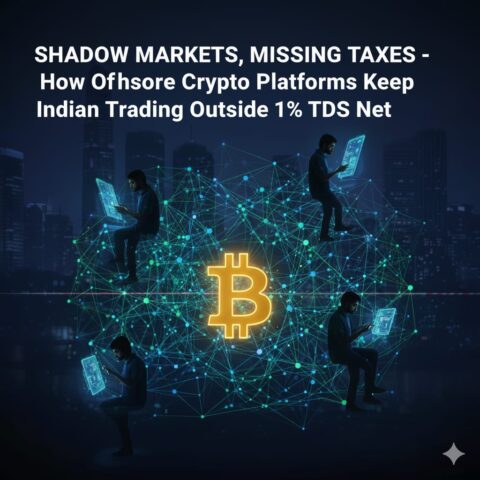FIU enforcement and URL blocking fail to curb offshore exchanges’ access for Indian users
New Delhi: The government’s twin-pillar crypto tax model—30% on gains and 1% TDS on transactions—is facing cracks as offshore trading grows. Without TDS collection, India loses both visibility and vital revenue.
Since December 2023, the Financial Intelligence Unit (FIU-IND) has identified and acted against non-compliant offshore Virtual Asset Service Providers (VASPs), issuing show-cause notices and asking MeitY to block their URLs. Yet the core issue persists: Indian users can still access many of these venues through apps, mirror sites, and VPNs, keeping activity outside the TDS perimeter.
The playbook is straightforward. Large offshore exchanges offer peer-to-peer (P2P) channels where they escrow the crypto while buyers and sellers settle payments directly via UPI or widely used apps like Google Pay, PhonePe, and Paytm. These exchanges place the responsibility of deducting TDS on individual users, effectively washing their hands of compliance. This structure allows faster, cheaper trading while keeping tax authorities in the dark. Analyses show a significant post-2022 migration offshore; Esya Centre’s 2024 update estimates uncollected TDS since July 2022 at over ₹6,000 crore, including ₹2,634 crore between December 2023 and October 2024.
Enforcement has intensified but remains uneven. On December 28, 2023, FIU-IND issued notices to nine offshore VDA platforms and asked MeitY to block their URLs—reiterating that offering services to Indian users triggers PMLA duties, regardless of jurisdiction. Some domains were geo-blocked, but access persisted via VPNs and mobile apps, while P2P rails continued to move INR flows. In 2024, the world’s largest exchange registered with FIU-IND after paying an ₹18.82 crore penalty, fulfilling AML obligations but still not automating 1% TDS deduction. On October 1, 2025, FIU-IND issued Section 13 notices to 25 offshore service providers and, under Section 79(3)(b) of the IT Act, sought takedown of their apps and URLs for operating without PMLA compliance. The core arbitrage endures: FIU handles PMLA, CBDT enforces TDS, and until exchanges deduct at source for Indian-KYC’d users, the tax trail remains dark.
A second, quieter reality deepens the loss: income tax on gains. The 1% TDS was intended to surface transaction-level data so that profit declarations under Section 115BBH could be cross-verified at return time. When trades occur offshore without source deduction, that information never reaches AIS/26AS, depriving enforcement of critical inputs. Studies project that continued offshore migration will not only raise the uncollected TDS tally but also enable widespread under-reporting of the 30% gains tax—an avoidable outcome if trading is re-anchored to compliant platforms.
Closing this gap requires aligning rules. PMLA registration ensures AML and CFT checks, but the Income-tax Act must clearly deem any platform-facilitated P2P trade within Section 194S, making the exchange the “person responsible” for TDS whenever either party is an Indian resident. Additionally, a lower TDS rate coupled with stronger third-party reporting could widen the formal base without discouraging participation.
For now, the reality remains unchanged. Offshore platforms—some FIU-registered for AML, others not—remain easily accessible to Indian users. Their most appealing feature is not leverage or exotic listings but frictionless, TDS-free P2P trading. Until that changes, India will continue to lose both the 1% at source and the visibility needed to enforce the 30% gains tax. The tools—statute, supervision, and targeted redesign—already exist. The question is whether policy can stitch them together fast enough to bring the shadow market back into the light.
